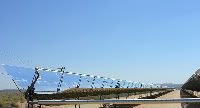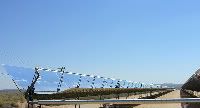Getting Concentrating Solar Power (CSP) Off the Ground


It seems that this subject: how does one get a CSP project off the ground – is the core concept of a trade show, the CSP Project Development Conference & Expo, coming in Denver in October. The show claims to assemble external decision-makers, lobby groups and government organisations to discuss how to solve CSP development hurdles and increase their speed to market. I think I might check this one out.

I believe renewables are the way forward. Coupled with a large dose of energy efficiency and a much reduced population (I don’t know how this will be achieved, but I believe it is essential).
Parabolic Trough technology has been providing reliable power, in some cases for over 20 years now, so there is very little grounds for argument that it isn’t working/viable/practical – whatever.
There are however areas in which the technology can be improved.
1. The reflectors themselves are difficult to make, brittle and therefore subject to breakage and very difficult to brace against distortion from the wind.
2. The framework which achieves the bracing constitutes a large portion of the cost of the plant and adds considerably to the total weight which has to moved in order for the reflector to stay “on sun”.
3. The collector tube has to move with the reflector thereby also adding weight to the whole apparatus, but more critically, requires the use of very complex and costly flexible joints to connect them to the HTF circuit. These joints have to be able to cope with the temperatures and pressures encountered in these systems and are clearly as major point of vulnerability given that they are in almost constant motion.
4. Because of all the weight that has to be moved, the mechanism which keeps the reflectors pointed at the sun has to be very robust and therefore quite complex.
I think these 4 points are essentially what is keeping troughs out of the mainstream today.
Power Towers have only been built up to 22MW and already the furthest mirror from the collector is almost a mile away. No need to enumerate the problems here.
Stirling Dish systems have similar windage problems as troughs plus they are relatively small in output and expensive to construct.
I think the answer is in Compact Linear Fresnel Reflectors. They are made from almost flat narrow strips of glass which are easy and cheap to make and just as easy and cheap to replace as required. Also, if one segment of mirror get damaged, the effect on the system is much less pronounced than it would be in a trough installation.
CLFR is mounted horizontally close to the ground, thus minimising windage distortion and because the reflectors are segmented, the wind factor is even further reduced.
But the biggest gain is in the fact that only the narrow strips of reflector have to move to track the sun requiring a much lighter far less complex tracking system. In addition to which, the collector tube doesn’t have to move either so no costly and vulnerable flexible joints.
I suppose one might have to concede a marginal reduction in efficiency, but at 30% less cost this can easily be overcome by a larger reflector area.
Other efficiencies are available too in the ease of manufacture. Most of the components of a CLFR can be manufactured from easily available local materials with existing skills and equipment- even here in Africa!!
My proposal is to drop the concept of centralised GW scale power plants and go for community owned distributed power using locally manufactured equipment which is simple enough for the locals to operate and maintain.